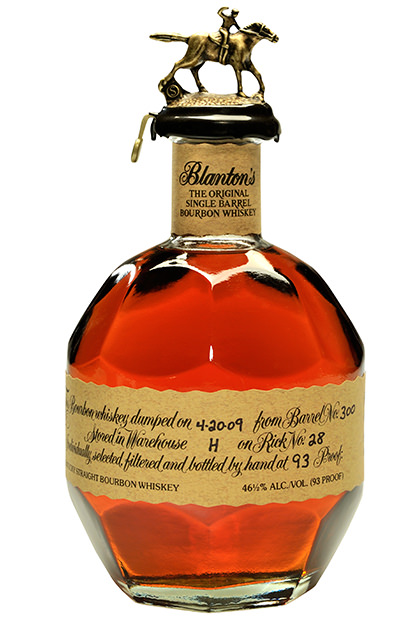If you’re a bourbon fan currently enjoying the spoils of a thriving whiskey market (or just celebrating September, National Bourbon Heritage Month), maybe pour a little out for Elmer T. Lee next time you take a sip. In case you didn’t know, there was a time not too long ago when the bourbon industry was actually failing. Lee is the guy who saved it.
By now—basically 30 years into its revival—it seems crazy to think bourbon ever needed a revival. The spirit’s revenue went up almost 10% last year (to about $2.7 billion dollars), and the Bourbon/Tennessee whiskey category actually drove the spirits industry’s revenue growth through 2014. Kentucky (not the only place bourbon can be made, by the way) has doubled its bourbon workforce and tripled the number of distilleries.
And far away from the scary world of employment trends and revenue flow charts, we have terms like small batch, single-barrel, and cask strength—now common boozehound parlance. People are even stockpiling bourbon like boozy doomsday preppers in the face of an actual bourbon shortage (supply can’t quite keep up with demand, and yes, those are the cellars you’d wanna end up in in the event of an apocalypse). This doesn’t seem like an industry that was ever in trouble. Clearly, we love our bourbon.
But we didn’t always. Back in the 1970s, bourbon was actually at the tail end of a steep decline in popularity. The Old Fashioned, whiskey-snifter ways of the Mad Men era were a thing of the past, and more people were drinking vodka and gin. While the hip night life scene drowned itself in clear swill, America’s whiskey was relegated to the none-too-flattering role of “old man drink,” where it stayed—and quality plateaued—for a while.
Enter Elmer T. Lee, Kentucky born and bred, fresh off a tour as radar bombardier in World War II—clearly an eligible candidate to be a hometown bourbon hero. Not that Lee brought the industry back overnight. He started working for Buffalo Trace (then called George T. Stagg) in 1949, working his way up the ranks (plant engineer, plant superintendent) to become the company’s first Master Distiller. But it wasn’t until 1984, 35 years into his career, that Lee took on the struggle of bringing near-forgotten bourbon back into relevance. And he did it with one bottle.
Well, one barrel, actually. At the time, the drinks market still wasn’t really interested in flavorful bourbon (1984 was the year Anheuser-Busch debuted King Cobra Malt Liquor), but Lee decided to give it to them anyway, with a kind of “if you bottle it, they will come” logic. As it happens, the distillery’s former president, Col. Albert B. Blanton, had been in the habit of taking bourbon from barrels in the middle of Warehouse H for his private reserve (he believed the bourbon in those barrels was the highest quality). So when it came time for Lee to shake things up a bit, bottling bourbon directly from a single barrel (no blending, trading consistency for singularity of character), of course he looked to Blanton’s beloved Warehouse H. And so Blanton’s Single Barrel was born, the first of its kind on the market.
Anytime a new bottle hits the market—be it game-changing bourbon or something blue and alcoholic, like Hypnotiq—intrigue is inevitable, as are at least a few sales. Because Blanton’s was so uncommonly good for its time, and so uniquely expressive from barrel to barrel, the intrigue of its first few customers became fascination, which then became dedication, and demand. Imitators have since followed suit, and by now single barrel bourbon is a well-established player in the once more healthy bourbon market. (Heaven Hill, Jack Daniel’s, Knob Creek and Four Roses all offer at least one, often several, single barrel options).
 But what’s exactly in Blanton’s? Well, it’s aged for eight years in newly charred white oak barrels, bottled at 93 Proof (a potent 46.5% ABV). The date the whiskey was bottled is always listed on the label, as is its now famous provenance, Warehouse H. And yes, while flavors will vary (since this is single barrel), anything from caramel sweetness to spice, clove, citrus, burnt sugar, vanilla, corn and honey come into play. Probably a lot more. Lee knew what he was doing.
But what’s exactly in Blanton’s? Well, it’s aged for eight years in newly charred white oak barrels, bottled at 93 Proof (a potent 46.5% ABV). The date the whiskey was bottled is always listed on the label, as is its now famous provenance, Warehouse H. And yes, while flavors will vary (since this is single barrel), anything from caramel sweetness to spice, clove, citrus, burnt sugar, vanilla, corn and honey come into play. Probably a lot more. Lee knew what he was doing.
Not long after creating Blanton’s Lee was honored with his own bourbon by the Buffalo Trace distillery, Elmer T. Lee Single Barrel. So just remember, if you buy a bottle of Blanton’s or Elmer T. Lee, be sure to pour some out for Lee. He passed away in 2013 at the age of 93 – the same proof as his namesake bourbon – almost thirty years after he’d brought his favorite drink back to life.
